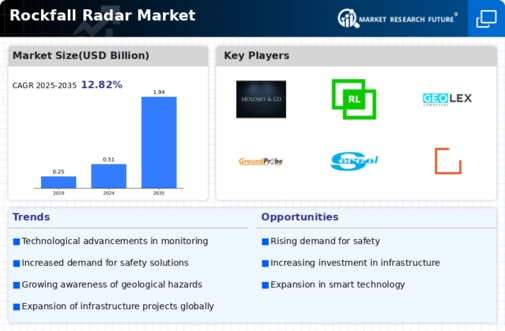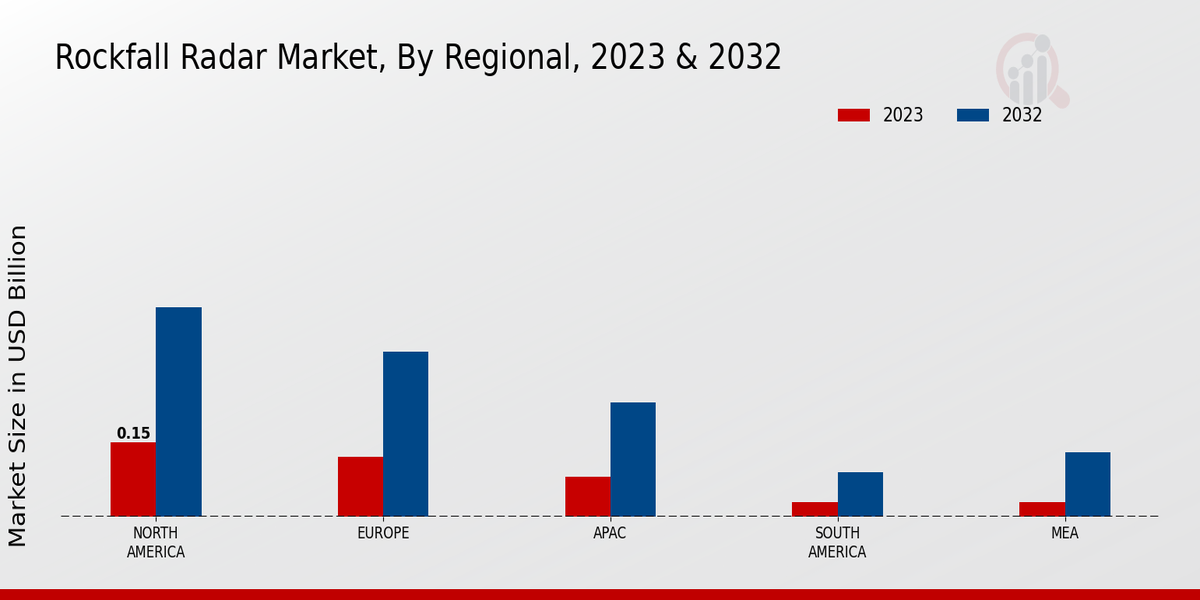Market Growth Projections
The Global Rockfall Radar Market Industry is poised for substantial growth, with projections indicating a market size of 0.51 USD Billion in 2024 and an anticipated increase to 1.94 USD Billion by 2035. This growth trajectory reflects a compound annual growth rate of 12.92% from 2025 to 2035, driven by factors such as increasing infrastructure development, rising safety awareness, and technological advancements. The demand for effective monitoring systems in geologically unstable regions is likely to intensify, as stakeholders recognize the importance of mitigating risks associated with rockfalls. This upward trend in market valuation suggests a robust future for rockfall radar technologies.
Rising Awareness of Safety Standards
There is a growing emphasis on safety standards across various industries, particularly in construction and mining, which is propelling the Global Rockfall Radar Market Industry forward. Regulatory bodies are increasingly mandating the use of advanced monitoring technologies to mitigate risks associated with rockfalls. For example, in regions prone to geological hazards, companies are adopting rockfall radar systems to comply with safety regulations and protect workers. This heightened awareness is likely to drive market growth, with projections indicating a market size of 1.94 USD Billion by 2035, reflecting a commitment to enhancing safety protocols in hazardous environments.
Increasing Infrastructure Development
The Global Rockfall Radar Market Industry is experiencing growth driven by the surge in infrastructure development projects worldwide. Governments are investing heavily in transportation networks, including roads and railways, which often traverse mountainous and unstable terrains. The need for effective monitoring systems to prevent rockfalls in these areas is paramount. For instance, countries like Canada and Switzerland have implemented advanced rockfall radar systems to enhance safety measures in their mountainous regions. This trend is expected to contribute to the market's valuation, projected to reach 0.51 USD Billion in 2024, as stakeholders prioritize safety and risk management in infrastructure projects.
Growing Urbanization in Geologically Prone Areas
Urbanization trends are contributing to the expansion of the Global Rockfall Radar Market Industry, particularly in regions characterized by geological instability. As populations migrate towards mountainous and hilly areas for housing and development, the risk of rockfalls increases. This urban expansion necessitates the implementation of monitoring systems to ensure public safety and protect investments. Countries like Brazil and India are witnessing rapid urban growth in such terrains, prompting local governments to adopt rockfall radar technologies. This trend underscores the market's potential for growth, as urban planners and developers prioritize safety measures in their projects.
Technological Advancements in Monitoring Systems
Technological innovations are significantly influencing the Global Rockfall Radar Market Industry, as advancements in radar technology enhance the accuracy and reliability of monitoring systems. The integration of real-time data analytics and machine learning algorithms allows for predictive modeling of rockfall events, enabling proactive measures. Countries such as Japan and Italy are at the forefront of implementing these technologies, utilizing sophisticated radar systems to monitor geological stability. This trend suggests a robust growth trajectory for the market, with a projected compound annual growth rate of 12.92% from 2025 to 2035, as more industries recognize the value of advanced monitoring solutions.
Increased Investment in Natural Disaster Management
The Global Rockfall Radar Market Industry is benefiting from increased investments in natural disaster management initiatives. Governments and organizations are allocating resources to develop and implement systems that can predict and mitigate the impacts of geological hazards, including rockfalls. For instance, the European Union has funded various projects aimed at enhancing monitoring capabilities in vulnerable regions. This focus on disaster preparedness is likely to drive demand for rockfall radar systems, as stakeholders seek to minimize risks and protect infrastructure. As a result, the market is expected to see substantial growth, aligning with broader efforts to improve resilience against natural disasters.













